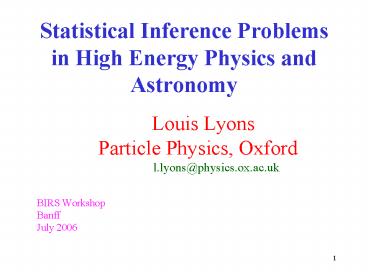Statistical Inference Problems in High Energy Physics and Astronomy - PowerPoint PPT Presentation
1 / 15
Title:
Statistical Inference Problems in High Energy Physics and Astronomy
Description:
Group A: Looking for interesting signal. Simplest example: ... than b, establish upper limit on possible excess from interesting new source ... – PowerPoint PPT presentation
Number of Views:26
Avg rating:3.0/5.0
Title: Statistical Inference Problems in High Energy Physics and Astronomy
1
Statistical Inference Problems in High Energy
Physics and Astronomy
-
Louis
Lyons - Particle Physics, Oxford
-
l.lyons_at_physics.ox.ac.uk -
- BIRS Workshop
- Banff
- July 2006
-
2
- Programme for Workshop
- Topics
- Aims
- Timetable
- What is Particle Physics?
3
Workshop topics
- Topic A1 Confidence limits
- Nuisance parameters
- Unphysical values
- Coverage?
- Very small intervals
- Topic A2 Estimating signal significance
- S/ ? B
- Nuisance parameters
- Look elsewhere effect
- Goodness of fit Sparse multi-dimensional data
- Multivariate analysis
- Cuts, Fisher, PCA, NN, SVM, Boosted Trees,
Bagging
4
Workshop aims
- Learn from statisticians about possible
approaches - Compare available methods
- Produce written summary of Where we are
5
Timetable
- Sunday
- a.m. Introductory Talks (plenary)
- p.m. Working groups
- Monday
- a.m. and p.m. Working groups
- Tuesday
- a.m. Intermediate reports
- p.m. Free for hike
- Wednesday
- a.m. and p.m. Working groups
- Thursday
- a.m. Final Reports (plenary)
- Conclude with lunch
6
Monday Talks
- Joel Heinrich
- Luc Demortier
- David van Dyk
- Byron Roe
- Nancy Reid
7
(No Transcript)
8
Typical Experiments
- Experiment Energy Beams events
Result - LEP 200 GeV e e- 107
Z N 2.987 0.008 - BaBar/Belle 10 GeV e e- 108 B
anti-B CP-violation - Tevatron 2000 GeV p anti-p 1014
SUSY? - LHC 14000 GeV p p (2007)
Higgs? - Super-K 3 GeV K?K 100
? oscillations
9
(No Transcript)
10
(No Transcript)
11
CDF at Fermilab
12
Typical Analysis, 1
- Parameter determination dn/dt 1/t
exp(-t/ t) - Worry about backgrounds, t resolution,
t-dependent efficiency - 1) Reconstruct tracks
- 2) Select real events
- 3) Select wanted events
- 4) Extract t from L and v
- 5) Model signal and background
- 6) Likelihood fit for lifetime and statistical
error - 7) Estimate systematic error t st
(stat) st (syst) - 8) Does data agree with expected dn/dt?
13
Typical Analysis, 2
- Group A Looking for interesting signal
- Simplest example
- Define set of cuts to select possible signal
- Expect b (sb ) from uninteresting sources.
Assume Poisson. - Observe n events
- A1 For n smaller or not much greater than b,
establish upper limit on possible excess from
interesting new source - A2 For n rather larger than b, quantify
significance of deviation. - Realistic examples have multivariate data, rather
than just one integer
14
Typical Analysis
Hypothesis testing Peak or statistical
fluctuation?
15
Typical analysis 3
- Try to determine properties of events containing
top-quarks (relatively rare) - Observe events, characterised by many variables
- Use training data (M.C?) for signal and for
backgrounds in multivariate classification
schemes, to separate top from backgrounds - Assess efficiency and purity for selection
procedure, including possible systematics. - Which variables, what method, what optimisation,
.. ?
16
Where we would like help
- Access to understood programs
- Multivariate analysis
- Cuts, Fisher, PCA, NN, SVM, Boosted Trees.
- Confidence limits
- Nuisance parameters
- Unphysical values
- Coverage?
- Very small intervals
- Estimating signal significance
- S/ ? B
- Nuisance parameters
- Look elsewhere effect
- Goodness of fit
- Sparse multi-dimensional data
- Combining results
- Asymmetric errors
- Overlapping data samples
- Correlated systematics































